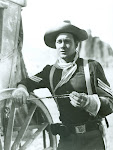
Mona Darkfeather (January 13, 1883 – September 3, 1977) was an American actress. During the silent era of motion pictures, from 1911 to 1917, she appeared in 102 movies. Playing Native American characters in a dignified way, her most-famous role was possibly as Prairie Flower in The Vanishing Tribe (1914). Her career began in 1909 when she replied to a local newspaper advertisement placed by producer/director Thomas Ince's Bison Motion Pictures. The movie studio was looking for someone with the physical attributes to portray an American Indian and who was physically capable of doing stunts and riding horses. While she had never acted before, Workman fit the appearance that Ince wanted. She apparently embellished her riding skills, as she did not have any, but nevertheless quickly learned horsemanship. Given the stage name Mona Darkfeather, she was cast in her first starring role as an Indian maiden named Owanee in the 1911 movie Owanee's Great Love. She was born Josephine M. Workman in Boyle Heights, California, and baptized at the Plaza Church, Los Angeles, when she was four months old. Her father was of English and Spanish ancestry, while her mother was of Scottish and Chilean. After replying in 1909 to a Bison Motion Pictures newspaper ad, which called for exotic-looking girls to play "Indian maidens," she soon became famous as Princess Mona Darkfeather, noted for leaping onto her pinto pony, "Comanche," and galloping away bareback. Darkfeather's early publicity claimed she was a full-blooded Blackfoot Indian. Though she freely admitted in interviews that she was not of Indian ancestry, she said she was an Indian Princess, that she had been made a blood member of the Blackfoot Nation and given the title of princess by Chief Big Thunder. So successful was the studio's promotion of Princess Mona Darkfeather that over the years, and even in 2005, she has been frequently referred to as an American Indian actress. She played Indian roles in one-reel western melodramas, such as A White Indian (1912) and A Blackfoot's Conspiracy (1912), as well as feature length movies. She was by then a major movie star. She also played leading roles as Spanish women in several historical dramas.
Darkfeather made movies for Bison starting in 1909, the Selig Polyscope Company between 1909 and 1913, Nestor Studios in 1912 and for Kalem Studios beginning in 1913. Many times the star worked under the direction of Frank Montgomery. He directed her in the Selig 14-reeler The Massacre of the Fourth Cavalry (1912), a sensational silent movie success. For Kalem their outstanding effort was The Woman Without a Soul. She and Frank Montgomery (whose birth name was Akley) were married in 1912. Other movies he directed her in include A Forest Romance, For the Peace of Bear Valley and Justice of the Wild, all released in 1913, in which she played opposite Harry von Meter. Darkfeather was Cecil B. DeMille's first choice to portray the Indian wife, Nat-u-ritch, in his famous western The Squaw Man (1914), but she was too busy, as she and Montgomery were producing their own movies independently for release through the Kalem Company, and she was unavailable to play the role. She and Montgomery joined the newly established Universal Studios, in 1914, and continued to collaborate on scores of westerns. Darkfeather appeared in her last movie, The Hidden Danger, in 1917, then retired from the screen. For a while after she retired as a screen actress, she performed on the stage and headlined as Princess Darkfeather. In late August 1918, she made a special appearance at the Liberty Theater in Tacoma, Washington, as actress, singer and lecturer. In her "rattlesnake" dress, she appeared after each showing of the feature movie, Eyes of the World (1917) starring Monroe Salisbury, to sing and give advice to all girls in the audience with ambition to enter show business. Mona Darkfeather died at age 94 from a stroke, due to cerebral atherosclerosis, at a convalescent center on South Crenshaw Boulevard, Los Angeles.
Darkfeather made movies for Bison starting in 1909, the Selig Polyscope Company between 1909 and 1913, Nestor Studios in 1912 and for Kalem Studios beginning in 1913. Many times the star worked under the direction of Frank Montgomery. He directed her in the Selig 14-reeler The Massacre of the Fourth Cavalry (1912), a sensational silent movie success. For Kalem their outstanding effort was The Woman Without a Soul. She and Frank Montgomery (whose birth name was Akley) were married in 1912. Other movies he directed her in include A Forest Romance, For the Peace of Bear Valley and Justice of the Wild, all released in 1913, in which she played opposite Harry von Meter. Darkfeather was Cecil B. DeMille's first choice to portray the Indian wife, Nat-u-ritch, in his famous western The Squaw Man (1914), but she was too busy, as she and Montgomery were producing their own movies independently for release through the Kalem Company, and she was unavailable to play the role. She and Montgomery joined the newly established Universal Studios, in 1914, and continued to collaborate on scores of westerns. Darkfeather appeared in her last movie, The Hidden Danger, in 1917, then retired from the screen. For a while after she retired as a screen actress, she performed on the stage and headlined as Princess Darkfeather. In late August 1918, she made a special appearance at the Liberty Theater in Tacoma, Washington, as actress, singer and lecturer. In her "rattlesnake" dress, she appeared after each showing of the feature movie, Eyes of the World (1917) starring Monroe Salisbury, to sing and give advice to all girls in the audience with ambition to enter show business. Mona Darkfeather died at age 94 from a stroke, due to cerebral atherosclerosis, at a convalescent center on South Crenshaw Boulevard, Los Angeles.
(Adapted from Wikipedia)








No comments:
Post a Comment